

Paul Allen Newell interview
By Scott Stilphen
(2008)

Former Western Technologies programmer "scrambles" up a burning building to answer "entombed" gamer's questions.
From Paul: "The above photo was taken of me the week after I had finished and delivered Scramble for the Vectrex (April of 1982). Within a month of this photo, I was working on resurrecting Towering Inferno from its end of 1981 state so I could make a game out of it for U.S. Games to release."
Q: Let's start with your educational background.
Paul Allen Newell: I have a BA (1976) from University of Wisconsin, Madison in art and communication arts with a focus on video and film. I received my MFA from UCLA Film School (1980) specializing in experimental video and computer animation.
Q: What inspired you to go into game design?
Paul Allen Newell: To be honest, all I was interested in was creating computer images. The game industry and the CG industry were in their infancy. All that mattered was getting "my first job", hopefully with computers and images.
Q: Were there any programmers or games that inspired you?
Paul Allen Newell: My main inspirations were films by John Whitney, Sr., and the work that Jim Blinn was doing at JPL with the Voyager missions to Jupiter and Saturn. The first games to really catch my eye were the early "post-Pac-Man" arcades ... Tempest, Centipede, Defender, etc.
Q: Did you work for anyone prior to Western Technologies (after school)?
Paul Allen Newell: Western Technologies was my first "real job" after getting my MFA from UCLA.
Q: How did you hear about WT? When did you start working there?
Paul Allen Newell: I found a posting in the UCLA job center and called them up. They interviewed me and apparently I was "put on hold" while they looked for someone better. My experience at that point was high level languages (Fortran, Basic, and "C") working with imaging on a frame buffer ... no Assembly language and no real-time experience. The story I heard later on was that the person who interviewed me went home that night and told his roommate about the interview. The roommate who had worked with me at UCLA in trying to get a Tektronix 4051 set up for student filming, said they'd be crazy not to hire me and listed everything he knew about me. They got back to me a few days later and offered me the job.
Q: We have very little information regarding WT so I’d be very interested in knowing more about them. I know it was owned by Jay Smith (and his brother?), and that there were at least two offices – one in Cali and the other in Florida (which mainly worked on hardware).
Paul Allen Newell: Jay Smith owned WT and he hired his brother, Ed Smith, during the Vectrex period. Ed was the project manager for the Vectrex contract. Everything was done at the Santa Monica office until after the initial set of Vectrex games was released. They opened the Florida office as a way to take advantage of the success they had with interns from Georgia (Chris King and Bill Hawkins) on Vectrex. I had no dealings with Florida; any hardware stuff they did would have been after my time.
Q: Were the Vectrex and Atari VCS systems the only platforms you worked on?
Paul Allen Newell: At WT, yes.
Q: What were the hours in your department? Was your schedule fixed (i.e. 9 to 5) or could you basically come and go as you pleased?
Paul Allen Newell: My hours were flexible, but an 8+ (major plus) was the order of the day. I would arrive around 10-11 in the morning but almost did a 12 hour day -- dinner was usually midnight. I was usually in at least one day of the weekend, or sometimes both. Everything was straight salary with no overtime.
Q: How did WT come to develop games for the Atari VCS?
Paul Allen Newell: As best I can remember, WT had 3 VCS games being developed for Kenner back in 1981. The Atari reverse-engineering project was known as "Breaker". Jeff Corsiglia and Tom Sloper were the two game designers at WT. Mark Indictor and John Hall were the other two original Breaker project programmers. I think Kenner already had the Towering Inferno license before approaching WT, as the game was always known as such from the moment I got the game. Star Trek was another licensed game Kenner wanted. I'm not certain of its history but I do know WT was working on it in 1981. The 3rd game was an original called "US versus USSR", which I am very certain never went anywhere after WT stopped work on it for the Vectrex project. I'm going to make a guess that Kenner sold the Towering Inferno license to U.S. Games.
Q: Were the titles you worked on assigned, or chosen by yourself?
Paul Allen Newell: Towering Inferno and Scramble were assigned. The work that eventually became Entombed was presented to management and they created a game out of it.
Q: Did you work with any graphics or sound artists? If so, do you recall who helped with what?
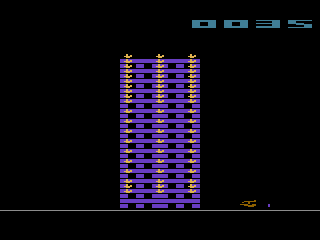 Paul Allen Newell: I worked with Jeff
Corsiglia on Towering Inferno and Tom Sloper worked on Entombed. The sound programmer for the Vectrex
games was Lenny Carlson (though I am reaching into the depths of my memory hoping I have the last name right). Kim Martin did the encoding of the Scramble landscape for me. I still have the scroll he created by playing Scramble over and over in "no death" mode. I should give a nod of thanks to Mark Indictor and John Hall, as we all contributed a lot to each other's games. I also want to acknowledge Duncan Muirhead, a math grad student from UCLA, who
taught my games math tricks beyond my skills.
Paul Allen Newell: I worked with Jeff
Corsiglia on Towering Inferno and Tom Sloper worked on Entombed. The sound programmer for the Vectrex
games was Lenny Carlson (though I am reaching into the depths of my memory hoping I have the last name right). Kim Martin did the encoding of the Scramble landscape for me. I still have the scroll he created by playing Scramble over and over in "no death" mode. I should give a nod of thanks to Mark Indictor and John Hall, as we all contributed a lot to each other's games. I also want to acknowledge Duncan Muirhead, a math grad student from UCLA, who
taught my games math tricks beyond my skills.
Q: What was the development process like with your games?
Paul Allen Newell: Regarding reverse-engineering, we poured over disassemblies of Atari and Activision games. That was our prime source. Somewhere along the line we got the Magicard, which helped show us some of the non-obvious aspects. We were still in learning mode when the Breaker project got cancelled and we moved to the Vectrex. When they asked me to finish Towering Inferno for US Games and to isolate the maze algorithm, I wasn't planning on doing any more 6502 as I knew I was going up Bay Area to do Simutrek.
Towering Inferno was a situation where they had the license to the game version of the movie and the general overall theme (tower, fireman, fires) but the game play had to be worked out. That was an iterative process between Jeff and myself to see how much we could pack in. The interesting thing on that game was that it was the original project that got canned when Kenner Toys backed out and we started on the Vectrex. Towards the end of the Vectrex project, U.S. Games approached WT about doing VCS games and management decided that of all the original VCS games, mine was the closest to being a game. Mark Indictor and John Hall had VCS games in development before Vectrex, but they had left to work for GCE as in-house Vectrex programmers, and nobody was available to take over their projects. Towering Inferno was resurrected from the archives and a couple more game play passes were done. This one went out to kid testing as well. I remember clearly that I made the deadline for the game and it got shipped, but Jay Smith's son discovered that the left player's score was on the right side of the screen and vice-versa. We were too far along the mastering process to redo it at WT, so I had to call up the folks making the PROMs and tell them to change one byte from "do on carry" to "don't do on carry" (or the other way, I can't remember). That is still one of the riskiest things I've done since they couldn't test and we just had to cross our fingers that I got it right (luckily, I did).
The maze algorithm for Entombed was created by Duncan and
myself. The opportunity to do the game based on the algorithm happened afterwards and I elected to not take that chance, so I never actually did the game. The story of the algorithm is that one night after work, Duncan and I went out for a beer and ended up coming up with this "problem" of wondering whether one could
generate an endless maze that always had a solution. At the time, we weren't thinking of a game per se, it just seemed like an interesting puzzle for us to solve. We worked out the algorithm and, since I knew how to program a VCS system (Duncan was Vectrex only), I spent a weekend coding something up. We were surprised at the elegance of the algorithm as it gave us the ability to dial in a "difficulty factor" (via a bit setting) and we could prove that there was not only a
point where it became unsolvable, but also a point on the other end of the spectrum where it became just an obstacle course as the se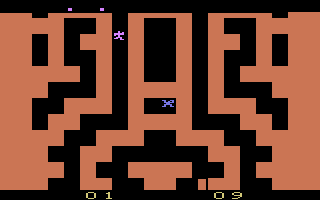 nse of paths vanished because there were too many possibilities. It always
auto-generated the next line, top or bottom, so when you scrolled down and then scrolled back up, you would often get a new solution. It was not symmetrically mirrored down the middle as the final game ended up. We knew we could extend it to work in a sideways direction, but the VCS didn't allow for lateral scrolling. We showed it to management and they thought this would make a great game. I expressed concern
that I was already pushing the limits of the amount of free time/drawing left. Nevertheless, they wanted to do it and the plan was for me to start it after I finished Towering Inferno. I was able to use part of the algorithm for the flame distribution in Towering Inferno.
nse of paths vanished because there were too many possibilities. It always
auto-generated the next line, top or bottom, so when you scrolled down and then scrolled back up, you would often get a new solution. It was not symmetrically mirrored down the middle as the final game ended up. We knew we could extend it to work in a sideways direction, but the VCS didn't allow for lateral scrolling. We showed it to management and they thought this would make a great game. I expressed concern
that I was already pushing the limits of the amount of free time/drawing left. Nevertheless, they wanted to do it and the plan was for me to start it after I finished Towering Inferno. I was able to use part of the algorithm for the flame distribution in Towering Inferno.
When I left, there was no "game", just the algorithm. Steve Sidley was hired when I left and inherited what became Entombed, with Tom Sloper as game designer. I have documentation of that in the form of framed games with plaques that WT had in the halls that were rescued when lots of stuff got thrown out (nobody could find the Scramble one). I quickly versed Steve in 6502 and the nature of the maze algorithm and took my leave. He took a lot of my code out to try to get room for game play. I never heard anything about it after that except rumors like "they released something in France". Finally, I learned that it had actually been released and found a copy on eBay. I dragged out my Atari unit and gave it a whirl. Steve had managed to somehow fit a game into it, though the maze had gotten much less complex (mirrored down the middle and an easier default setting which I think allowed them to skip a chunk of the difficulty control and buy some extra drawing cycles). I found one of my original EPROMs and compared it to the release. Although I am impressed with what Steve did, I still like the simple elegance of just having the maze which one could rapidly scroll through and visually track a solution. The original algorithm was a much more powerful maze, but it wasn't a game and Steve Sidley deserves the credit for crafting a game out of my code.
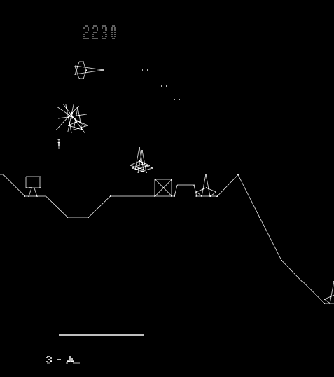 For Vectrex Scramble, it was rather straightforward as the goal was to make a faithful copy of the original arcade game. They bought the game and installed it at WT so I could play and play ...
and play ... until I had a feel for the game. Kim Martin went through the entire game with collision off so he could map the terrain into a hex database, which allowed me to write a driver to display it on the Vectrex. At that point, I was just doing version after version as I tried to make my version match the original arcade. Lots of folks in the office would try it to see if it had the right "feel" (speed of motion, responsiveness of joystick and buttons, etc.). The
biggest task was trying to get my code to fit into 4K without losing too much of the game. I think I got done about a half-day before the final ship date and know that no changes were made after.
For Vectrex Scramble, it was rather straightforward as the goal was to make a faithful copy of the original arcade game. They bought the game and installed it at WT so I could play and play ...
and play ... until I had a feel for the game. Kim Martin went through the entire game with collision off so he could map the terrain into a hex database, which allowed me to write a driver to display it on the Vectrex. At that point, I was just doing version after version as I tried to make my version match the original arcade. Lots of folks in the office would try it to see if it had the right "feel" (speed of motion, responsiveness of joystick and buttons, etc.). The
biggest task was trying to get my code to fit into 4K without losing too much of the game. I think I got done about a half-day before the final ship date and know that no changes were made after.
I should note that each game/developer had their own working process. With the exception of constant visits from management to make sure things were on schedule, everyone was pretty much allowed to develop at their own pace/style. I did hear that things got more formalized in later games, but I can't state that as a fact as it was third-hand info.
Q: It's a long-held belief that games based on movies are inherently 'cursed', and that holds true today more than ever. Towering Inferno is one of the few movie-based games that works – it was a good idea for a game, and the game is both original and fun.
Paul Allen Newell: On principle, I would agree that games to/from movies do not make for a natural mix. I would have expected today’s hardware to allow for a complexity to at least bear resemblance to the movie of its name ... but I've been out of that field for so long that I really am not even qualified for speculating on it. I've always wondered how much better Towering Inferno could have been if I had the same level of technology that Doom had to work with, but in general they worked as games within the context of what technology could give at the time.
I remember having conversations back in the 1980's about the problems with all movie tie-in games as the technology just couldn't support it. Those conversations included the use of computer animation in commercials and films (this would be the "TRON" era). I think it’s why I was partial to games such as Scramble, as they worked within the context of what technology could give and weren't tied to another media like movies.
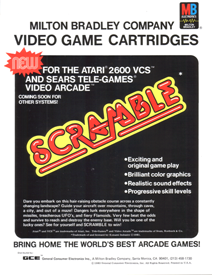
Q: Flyers exist for both VCS Scramble and Star Trek. Being you did the Vectrex version of Scramble, were you approached about doing a VCS version?
Paul Allen Newell: I never knew that GCE (Milton Bradley) was considering the VCS format, and nobody ever talked to me about doing a VCS version of Scramble. I would have thought would have been impossible to be true to the arcade version, since scrolling is vertical in the Atari and Scramble is so heavily invested in the visual and design of horizontal scrolling. But,
maybe someone knew a way to figure that out (when I was doing my version of an endless maze which would work north/south and east/west, I couldn't see a way to pull it off).
Q: What did you do after leaving WT?
Paul Allen Newell: After leaving WT, I went to Simutrek to try my hand at an arcade game called Cube Quest. We had a very powerful hardware system with laser disk images produced by Robert Abel & Associates, who had a piece of the company, but the game was released way too early and the game play never really got a chance to be developed beyond first experiments with the final hardware.
One could probably write a novella on the development on this one, so let me try to do the Cliff Notes summation. When I arrived at the company, i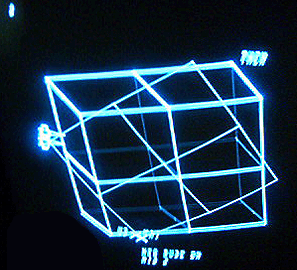 t literally
was "day one" (just an empty building with 6 people sitting on the floor --- two programmers (Duncan from WT and me), one hardware engineer, and three management folks). Since we were designing the hardware from scratch, a deal was worked out with GCE to allow us to use the Vectrex as our developing environment so that Duncan and I could start creating libraries we'd figured
would be needed. Very early in the process, an off-site was held for all 6 of us and others who were active participant investors (equity in trade for their expertise). The noticeable two were Bob Abel and Bill Kovacs from Robert Abel and Associates who, in return for their equity position, were going to produce the imagery that was going to be used for the laserdisc in the game. Everyone got to pitch an idea and then we worked through what seemed like the best
options. For better or worse, my idea came out on top ... a "cat-and-mouse" style game played on a topology roughly modeled after a Rubik's cube in which Abel's would produce the environments between the nodes of the cube that each game play level would occur in.
t literally
was "day one" (just an empty building with 6 people sitting on the floor --- two programmers (Duncan from WT and me), one hardware engineer, and three management folks). Since we were designing the hardware from scratch, a deal was worked out with GCE to allow us to use the Vectrex as our developing environment so that Duncan and I could start creating libraries we'd figured
would be needed. Very early in the process, an off-site was held for all 6 of us and others who were active participant investors (equity in trade for their expertise). The noticeable two were Bob Abel and Bill Kovacs from Robert Abel and Associates who, in return for their equity position, were going to produce the imagery that was going to be used for the laserdisc in the game. Everyone got to pitch an idea and then we worked through what seemed like the best
options. For better or worse, my idea came out on top ... a "cat-and-mouse" style game played on a topology roughly modeled after a Rubik's cube in which Abel's would produce the environments between the nodes of the cube that each game play level would occur in.
The hardware was a line-buffer system with a laserdisc for background. This rasterized line-buffer was a new step within the technology of the game industry. The hardware process was a major leap of faith and a huge investment of time and energy. Duncan and I started working on the game prototype with me doing the game and Duncan customizing libraries. Once we had a test version, we did an internal "vote of confidence" and we decided we should go forward. That was probably the last moment that we could have considered something else and, in hindsight, that might have been the right thing to do. Too much of what I needed depended on having a final version of the hardware so I could figure out how to work with the graphics hardware and take advantage of its capabilities.
Somewhere around this time, Duncan moved over to the hardware team to write the microcode for all the different parts of the graphics pipeline. I had ported the game from the Vectrex to an early version of the hardware and was fleshing it out. One of the first tasks was to design all the imagery that Abel's would need to generate and I had the pleasure of serving as the outside art director for that project. Lots of ideas from lots of people (including three student interns from a local Hayward collage's art department) for different corridors in which we mixed and matched computer animation, traditional animation, and motion control. All the corridors had to be "cyclic" and mapped out to allow the laserdisc to have an entry, an endless loop for the middle, and an exit. Bill Kovacs, an outside consultant working on the laser disk hardware, and I developed a whole set of algorithms for handling this. We created a couple test laserdiscs which allowed me to program up the game to test validity of each.
We brought on someone to do sound and the game slowly began to come together. However, it was moving slower than the schedule would allow and by the summer of 1983, it was clear that the hardware was taking so long and was so complex that I wouldn't get enough time to utilize all the features that wo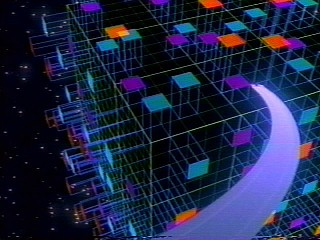 uld
have made the game worthwhile. I remember one night in June talking with Duncan and both of us having the "aha" moment that "we were doomed". Unless management gave us more time (3 months minimum, half a year to be safe), the game was going to go out in an incomplete state. Management did get more people to work on the hardware, but it was a huge amount of work and people were getting burned out. Then the lead hardware designer threw in the towel and quit, the rest had to
take it from there, and that sealed the sense of being doomed without more time. Management was committed to showing at the October 1983 Arcade show in New Orleans, with a release at the end of the year. We got the impression that there wasn't any more money to delay; a revenue stream had to happen by the end of the year per the start-up's original financial map.
uld
have made the game worthwhile. I remember one night in June talking with Duncan and both of us having the "aha" moment that "we were doomed". Unless management gave us more time (3 months minimum, half a year to be safe), the game was going to go out in an incomplete state. Management did get more people to work on the hardware, but it was a huge amount of work and people were getting burned out. Then the lead hardware designer threw in the towel and quit, the rest had to
take it from there, and that sealed the sense of being doomed without more time. Management was committed to showing at the October 1983 Arcade show in New Orleans, with a release at the end of the year. We got the impression that there wasn't any more money to delay; a revenue stream had to happen by the end of the year per the start-up's original financial map.
This is where I skip all the painful details of getting that game to New Orleans and everyone coming to understand that this just wasn't going to work out. The hardware team did a fantastic job and actually got a pretty good working version ready by October. I remember that the name of the person who replaced the guy who quit was Joe ... but I can't remember his last name (Ed. Joe Corkery). Chris King was also part of that effort and they did a great job. Duncan spent many a long night making the microcode perfect ... I was so looking forward to programming it and making Cube Quest into a real game that folks would really enjoy. But, it came out early, the public rejected it, and in January of 1984, they shut the place down except for the bare minimum needed to build as many of these arcade boxes as parts on hand would allow. One morning there was a guard at the gate and nothing but "obviously personal stuff" was allowed to be taken out.
I have seen email threads about "the holy grail of finding a Cube Quest game". All I can say is that the game just isn't worth all the interest. The hardware was slick and the laser imagery was state-of-the-art at the time. But all in all, we failed. As the game designer and lead programmer, I take the bulk of the responsibility for the failure. I underestimated the task and didn't have the courage to tell management that "we were doomed" when I realized it myself. That pretty much ended my career in games. A year and a half later, Steve Sidley, who had ended up at Abel's, hired me to work with the people who had done my imagery. It was an interesting first day when everyone went, "Hey, aren't you the person from that game company". I found a listing on the wall of all the jobs of the last couple years and, under Simutrek, the description just said "Don't Ask !!!".
Q: Did Simutrek have any other games planned?
Paul Allen Newell: They were beginning to work on a car race game. Michael Gomez was the lead on that (I believe he was from Cinematronics). There were some other ideas, but none that had progressed further than just talk.
Q: With your games, were there any features you would have liked to added, or any known bugs or glitches that gave you trouble (or never got resolved)?
Paul Allen Newell: The answer is "of course", as any programmer will tell you. To the best of my knowledge, there are no reported bugs in Scramble or Towering Inferno, so I don't have the issue of "if only I had fixed that". My biggest wish is that they would have given me 8K and not 4K for Scramble as I could have not only exactly matched the arcade but done better. My original code hovered in the 5K to 6K range and had a much better collision-detection code. I must say that the released version is pretty good unless you try to intentionally find the holes by trying to "back into" something. As for Towering Inferno, I've seen postings on the web that the fire can land on the fireman and he won't die, hence it's a bug. The truth is that we were not sampling all the time, owing to the constraints of the Atari VCS system. At times, it was every other redraw cycle. When I wrote the game, I considered it a system constraint and the bug was a "hardware issue". In hindsight, I don't think it is a bug but have to admit that I might not have known enough to get around the "hardware issue".
Q: Do you remember what early or tentative titles your other games had (if any)?
Paul Allen Newell: Other than the VCS “Breaker” project, no other code names were used that I remember. All my game titles remained the same throughout their creation.
Q: Were there any games or projects that you worked on that ultimately never got released or even finished?
Paul Allen Newell: I was lucky in that everything I worked on got released. As I mentioned earlier, when Simutrek first started, we didn't have any hardware and they cut a deal with GCE to let us use Vectrex systems as our initial development stations. So, the test model for the Cube Quest algorithm was developed in 6809 on a Vectrex as a simple "cat-and-mouse" style game as proof of concept. This was never released until the folks from CGE contacted me and I agreed to let them release the game "as is" at one of their conventions. So, I got another Vectrex title in the early 2000's. There have been complaints that "this isn't a game", but CGE and I introduced it as a "proof-of-concept", not a game.
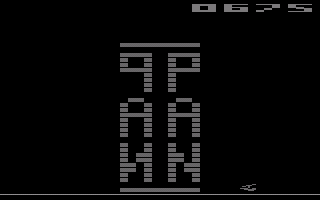
Q: So far your Easter egg (initials) in both Towering Inferno and Scramble have been found. Did you hide them in any other titles? Do you recall any fellow co-workers that put them in their games?
Paul Allen Newell: There are no other ones. I don't think there is such in Entombed as space was way too tight. I don't remember Steve telling me there was one.
I remember going through long discussions with management about giving the programmers credit on the games. Western Technologies and/or GCE didn't approve it and most of the programmers hide their names somewhere in the games.
Q: I also noticed a short (10 second) clip near the end of this video of a topless woman on the Cube Quest laserdisc. I can't imagine it was possible to trigger this to appear (on an actual machine), but I have to ask :)
Paul Allen Newell: This was very easy to trigger as it was part of the test section of the laserdisc and the game had a self-test mode. She's as topless as anything you would see in a PG-13 film. The technical reason it was put there was to give a "face tone" for doing color adjustment (I think there may be a standard one from Kodak as well). I have no idea who the woman is or where the shot came from; that was
100% from the test debug mode programmers, who were having a bit of fun. Since it is accessible during test mode, I find it hard to call it "hidden".
Q: If you had a chance to redo any of your games, what would you change (if anything)?
Paul Allen Newell: Make Scramble 8K and do it right, though the released version is pretty good in my opinion. As for Entombed, it is Steve's game. I can't think of anything for Towering Inferno ... and a complete rewrite of Cube Quest is mandatory.
Q: Did you ever attend any industry shows, such as CES or Toy Fair?
Paul Allen Newell: CES for a couple of years (WT and after). E3 once in the 1990's. The arcade show for the introduction of Cube Quest in 1984. My "show of choice" has been SIGGRAPH, which I have attended since 1982, though nowadays I am migrating to smaller venues more focused on my interests (Symposium on Computer Animation and the stereoscopic conferences).
Q: Since Simutrek, can you describe your career, between then and now, and where you’re currently working?
Paul Allen Newell: I did a consult with Activision when Simutrek went belly-up, but nothing came of it. I really wanted to get into the CG production world and in late spring of 1985, I noticed an ad for Abel Image Research (the technology branch of Robert Abel & Associates) in which the contact was Steve Sidley. I called him up and he offered me a job on the grounds that anyone who could do those VCS and Vectrex games could handle graphics software for production. We both had a good laugh on all this given that I had taught him 6502 and the maze algorithm 3 years earlier.
I've been in production ever since 1985. First with Abel's, then a stint in London with a company that had bought Abel's software and needed a support programmer when Abel's went belly-up. When I came back to the States, I went to Rhythm & Hues (started by 5 ex-Abel employees) where I first worked in production as a technical director for commercials, then moved back into software to take over the initial proprietary animation software. They had been using Wavefront while they wrote their own applications. When one of the owners, who had been doing the model and animation packages, elected to leave, I inherited his code (which was just coming on line). I got my first film credit on Babe for my animation software. The Coca-Cola Polar Bears commercials were also done with it. I then led a software team for the next generation animation package called "voodoo" which is still in use today at R&H, though greatly enhanced (though I do think some of my code is still there). I did a stint as the manager of the character animation department, but got caught in a layoff as programmers were sacred but not managers. I wound up at Disney Feature Animation working on their layout department software for both 2d and 3d films (mostly the hybrid 2d3d ones like Treasure Planet) and wrote all the stereoscopic layout software for Meet The Robinsons. Phil "Captain 3D" McNally was the stereoscopic supervisor. Chicken Little was their first stereo film, but they sent the mono cameras to ILM to make the stereo version. On Meet The Robinsons, we did both cameras in layout in-house and then shipped that off to Digital Domain to render the stereo. Shortly after finishing that, I moved to DreamWorks to work on their stereo software (Phil had joined DreamWorks about 4 months earlier). They announced shortly before I joined that they are doing all films targeted 2009 and later in stereoscopic format. I am also doing work in pre-viz, which is another new project.
What's interesting is that as we look at pre-viz, one of the strong models is the game engine technology and I find that the two fields are merging now that processing power allows games to be more visually robust and the cg entertainment business sees the real-time aspects of games as a way to get rapid turnover in ideas. It’s still got a way to go as there are definitely differences in the two worlds, but the technology is converging.
Q: Do you still own any of your games for these systems, either as a keepsake, or to show friends or family?
Paul Allen Newell: I have all my Vectrex and VCS released versions and original PROMs and game units to play them. They're mostly keepsakes, though I periodically toy with trying to move them up to a Linux platform ... but probably this will always be a "would be nice to do but never get to it" project.
I do not have a Cube Quest arcade game ... I really wasn't happy with the job I did and, when Simutrek went belly-up, all I wanted was the laser disk imagery. Being the client art director for the project at Abel's was a great learning introduction to the land of cg production. I have the original 1-inch master of the laserdisc imagery from the edit in 1983. I archived it to digital beta and luckily we put two copies on (in case the laser player found a problem in one, it could use the second). The first segment shows some laser rot, the second is in much better shape. I also have the original test discs and they are probably in not so great shape. My budget only allowed me to archive one, so only the master was saved. I also have a Japanese demo ROM set for (arcade) Cube Quest. I donated the EPROM images of the last version I have of CubeQuest to the Dragon's Lair Project website, so they are freely available.
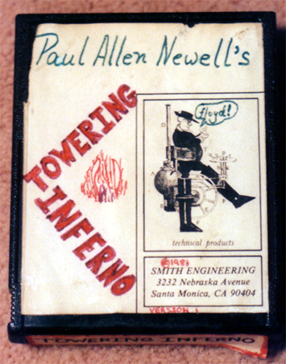
Paul's late 1981 WT in-house version of Towering Inferno, when Kenner canceled the Breaker project and before working on Scramble for the Vectrex.
Q: How were backups handled back then, as far as how often you or others made them. Daily? Weekly? And were they primarily done on floppies, or did the computer system you use have a 'master' list of everything in development?
Paul Allen Newell: I archived whenever I thought I had a milestone. The machine I was developing on just had the large size diskettes (can't remember the width, though 6-10 inches comes to mind). No other backups were made ... WT only had workstations and no network.
Q: Have you stayed in touch with any of your former co-workers?
Paul Allen Newell: Mark Indictor and I get together for dinner every once in a while, but that's about it.
Q: What are your thoughts on how the industry has evolved?
Paul Allen Newell: This is a question to ask once I have gotten a better sense of the current game engine technology as it applies to pre-viz in the film world.
Complete laserdisc footage from Simutrek's Cube Quest:
As an added bonus, Paul is making both the documented source code and original instructions for his Atari VCS game, "Towering Inferno", freely available for distribution on the condition that they remain unaltered.
Also, neither the source code or instructions are to be sold by anyone, in any form.
In December 2022, Paul sent me photos he took of awards that Western Technologies had created for Entombed and Towering Inferno. From Paul:
"The awards were created after the fact. I had long left WT and was in the CGI/VFX world when we hired someone who had worked at WT after me and, when things began to shut down, "liberated" these. He said the Vectrex ones were already gone and we suspect Jay Smith might have held onto them."
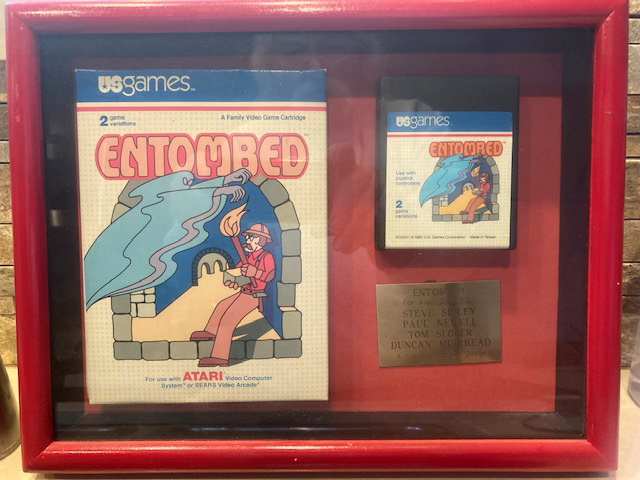
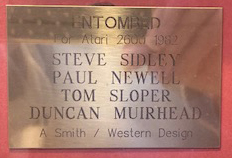
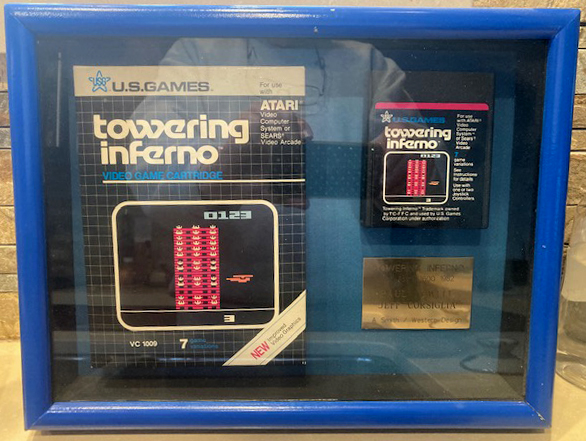
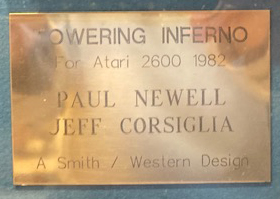
| GAME | SYSTEM | COMPANY | STATUS |
| Towering Inferno | Atari VCS/2600 | U.S. Games/Western Technologies | released |
| Entombed (maze algorithm) | Atari VCS/2600 | U.S. Games/Western Technologies | released |
| Scramble | Vectrex | GCE/Western Technologies | released |
| Cube Quest | arcade | Simutrek | released |
| Cube Quest | Vectrex | Simutrek | not completed |